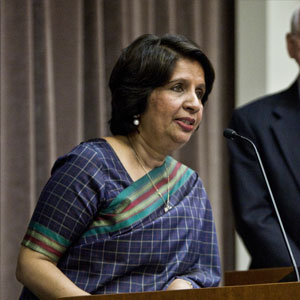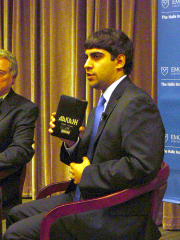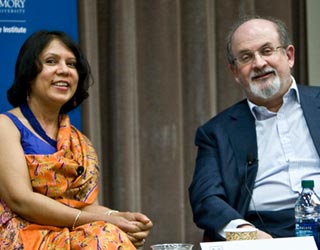3rd Annual India Summit discusses medical tourism, art, and more

Top: Ambassador Nirupama Rao’s keynote address and comments demonstrated her knowledge, perception, and humor. She is seen here taking questions, as Ambassador Marion V. Creekmore, Jr. looks on. (Photo: Wilford Harewood)
The previous two India Summits held at Emory University were called the “Emerging India Summit” and showcased the paradigm shift in the world from developed to emerging economies. Tellingly, this year’s summit dropped the term “Emerging.” Held at the Goizueta Business School on March 2-3, 2012, it brought together distinguished business leaders, medical experts, foreign policy experts, scholars, and most notably Her Excellency Nurupama Rao, newly appointed Ambassador of India to the United States.
After jobs, and closely connected to them, one of our major concerns in the United States is healthcare. With costs skyrocketing and health insurance not always available—for many different reasons, more and more people are traveling abroad for medical care, around 875,000 now per year. Of these, 150,000 people travel to India to save on health care procedures, bringing about $2 billion to India in 2012. Could medical tourism be the next IT?
Manoj Jain, an Emory physician and teacher and a writer for the Washington Post introduced writer and filmmaker William Bearden, who winningly described his experiences. From a need to obtain health care without health insurance, and without losing everything he had attained in life, to his search for quality and trustworthy care overseas, to his final bill of $9,000 in India instead of $300,000 here, his journey was illuminating. Having found a level of personal care, “humanness,” there that meant the world to him and helped him heal speedily, he now helps others on that same path.
Besides the search for lower cost care, quality is a prime concern. Yehuda Dror, president of DNV Healthcare, a risk management institution founded in 1864, shared that being in the hospital is seven times more risky than his sport, sky diving! Accreditation with an organization that focuses on managing risk by finding local solutions and innovations for process improvement can reduce the anxiety of going overseas.
Dr. Devi Shetty, founder of a hospital in Bangalore, joined the discussion by Skype to explain that while IT creates 5-7 jobs, healthcare creates 250 jobs for the same amount of money, with the result that the economy of the 21st century will be driven by the health sector. He predicted that India will be the first country to dissociate healthcare from affluence, providing hi-tech care with dignity. With an aging population, how can taxpayers pay for healthcare? An example of an Indian solution is 1.7 million farmers in a cooperative paying 11 cents per month with the government chipping in 7 cents. Hospitals that are underutilized offer services at a discount. If so many people can spend on mobile phones, then a little higher payment could provide 700 million Indians with health insurance! Delivery of healthcare is the next area for innovation. Health insurance companies, he said, are like travel agents—losing significance, since the government will act as a nonprofit insurer with tiny management cost. Audience questions prompted discussion of fraud (18-20% of expenditures here) and moral hazard (45%), concluding that society needs a robust discussion on end-of-life, etc.
Dr. K.M. Venkat Narayan described his research in India on diabetes. Prevention is cheaper than cure. You can have a high proportion of body fat even if you look thin. A history of famine in India combined with lost physical activity and lower quality of nutrition has shifted the problem in 10 years from undernutrition and infectious disease to obesity. It is no longer a rich man’s disease, as processed foods become more prevalent and cheaper.

Tarun Wadhwa shows the audience an Aakash—India's potentially revolutionary $35 tablet (the premium version pictured here runs $57). (Photo: Suzanne Sen)
With the world in a digital age, issues of trust, privacy, and security are significant. Tarun Wadhwa of the Think India Foundation and Distinguished Professor of Information Systems & Operations Management Benn Konsynski of Goizueta Business School discussed India’s new national identity system—the largest of its kind in the world. It has arisen from the need to prevent fraud from ghost or nonexistent identities, duplicate identities, and wrong identities leading to improper allocation of benefits. There is no fear of the system being an invasion of privacy, as we might see it here, since not having an identity card in the developing world means exclusion from services, while not having one in the developed world would only mean inconvenience. By using two of the three available biometrics—e.g., fingerprints and iris scan—99% of the population will be covered. Biometrics were explained as something you are, compared to something you know like a password, or something you have like a key. With 60,000 babies born every day in India, the goal is staggering. In 1990 there were 1 or 2 systems existing, but by the end of the decade it is predicted that more than 70% of the world will be identified in such a system. It is worth remembering that uses do vary: in Nordic countries people have benefited; in China it may be dangerous.
 Emory University Distinguished Professor and celebrated author Salman Rushdie in conversation with Associate Professor of English
Deepika Bahri.
Emory University Distinguished Professor and celebrated author Salman Rushdie in conversation with Associate Professor of English
Deepika Bahri.
(Photo: Wilford Harewood)
For Salman Rushdie’s discussion of the direction of modern art in painting, installation work, writing, and film, see our Website Bonus Feature for this report online [below].
The full text of Ambassador Nirupama Rao’s keynote address is also available [see below], thanks to the Indian Embassy—although not her off-the-cuff comments, such as, “Be yourself—you need support and a lot of determination,” and “There are three million Indian-Americans here—you should start a cricket movement!”
Website Bonus Feature
Salman Rushdie:
India Summit 2012, Friday, March 2: "Art in India," Salman Rushdie in conversation with Deepika Bahri.
"Take a whirlwind tour of art in India with one of the greatest writers of our time, Emory University Distinguished Professor Sir Salman Rushdie. This session [was] introduced by Emory University Vice President and Secretary Rosemary Magee and moderated by Deepika Bahri, associate professor of English and curator of the Salman Rushdie archive at Emory."
Professor Bahri began the conversation by commenting that in India one likes to get one's money's worth—paisa vasool; this conversation covered a variety of topics under the heading of art in India, and certainly satisfied the audience's desire to glean a few gems from Sir Salman. The following hits some highlights of the conversation.
Rushdie jumped into the topic of the visual arts by confronting the major problems:
1) There is a burden of greatness placed on the shoulders of artists by the legacy of thousands of years of superb painting and sculpture. With such a history, artists can find it difficult to remove themselves from the influence of the past and move on.
2) The influence of Western art and, even more unfortunately, the Western art market can change the natural direction of Indian art. For example, Indian art has been focused on the figure and on narrative. Since painting and this type of painting is less fashionable now in the West, some Indian painters are pandering to the Western market by turning to the more fashionable field of installations. But where there may be one good painter, there may be several artists good at installations. This excessive influence means a loss to painting.
Does Rushdie have a collection of paintings? He knows some painters, and in fact he has a Husain, done as a gift to his son. Does it have horses? There are always horses!
Some of his fiction features a Bohemian artist—is it taken from life? His character of Aurora is taken from the real painter Amrita, half Indian and half Hungarian, who died suddenly at age 38. Her life of a nonconformist gave him material for his book. In writing it, he delved into the milieu of the artist, having to visualize what his character's paintings would have been like—what would be the visual equivalent of his literary ideas—which was a creative exercise. It is easy, he says, to talk to artists across disciplines, for they have a lot in common—the desire to create.
The idea of worth, however, is dangerous if it takes the artist to the marketplace. How do we judge worth? Van Gogh sold only one painting—the market is not the place to determine value. Both visual arts and poetry have been of paramount importance in India. One difference to note is that a work in the visual arts is generally unique—a sculpture, a painting (as opposed to a photo, a poster)—whereas a literary work can be reproduced. Multiple copies, of course, affect the price, but this is not necessarily the same as the worth.
What threatens art? Religion. The visual arts and the written word are now subject to attack by religion, not one but all religions. There is an "escalating competition of offendedness." One artist has been forced into exile, his material going to a museum in the Gulf, when it should be in India. Recently there was an attack on a gay artist who had done nude paintings—but how much nudity has there been in thousands of years of Indian art? A lot. Not only is there increasing assault, but the authorities blame the artist for stirring up the violence [like women victims of violence who are accused of having provoked the assault]. The feeling is that censorship for the sake of harmony is better than free speech. This can cripple the artist. Even Shah Rukh Khan met this sort of attack when speaking of Pakistani cricketers. With such culture wars and an acceptance of censorship, an unwillingness of people to speak up and defend art and free speech means that not only is art in trouble, but more may come.
The case of the painting of an unclothed Saraswati? Saraswati has been nude in sculpture for thousands of years! Indian goddesses have jewelry, yes, clothes, no. Is this therefore an ignorance of Indian tradition? Or was the problem that it was a Muslim artist painting a Hindu goddess in the nude that irritated the religious faction? It should be noted that in Akbar's time there were Muslims and Hindus working on the same paintings. That was certainly better.
Songs: Rushdie was recently participating in an award ceremony for song lyrics [the PEN New England award for literary excellence in song lyrics]. Many song lyrics, he noted, are garbage. But the judges for this award were of high quality: Smokey Robinson, Rosanne Cash, [Bono, Elvis Costello, Paul Muldoon, Paul Simon, and Rushdie]. He noted that Carole King is another worthy of mention. Poetry and song have been related through the ages.
Books and movies have been related more recently. Are the skill sets for each different? Of course. The book can be more straightforward in a way, telling the interior life of its characters directly in words. The movie, on the other hand, is composed of exterior action that expresses the interior—which takes a different skill, the rule of "show-don't-tell." Rushdie is a writer first, but grew up in Bombay surrounded by movies, drenched in movies. The late 50s to the early 70s was a time of great art cinema: imagine going to the movies, week after week, seeing new films by Truffaut, Kurosowa, Bergman. It was an extraordinary time with a number of great filmmakers working at the same time—exhilarating. It was a higher quality than Bollywood now. Anyway, what the filmmaker must do is not explain a story or a character but close the eyes, see it, and write it down.
Apart from the arts cinema at one end of the spectrum and the popular cinema with its item numbers at the other end, there was an interesting middle ground, a middle cinema, of serious films. Now, that middle cinema is rising again, and film festivals are increasing in quality.
Film editing: In the making of Midnight's Children, Rushdie's cinematographer made their relatively modest budget look like a million dollars. He moves from the epic to the intimate, and it looks extraordinary. One major skill for films is editing. The first cut of The Godfather was bad. At the end of a year, they had a masterpiece. He quoted Francis Ford Coppola as saying, "No film is ever as good as the rushes and no film is ever as bad as the first cut." [Coppola also said, "The essence of cinema is editing," and "You have to really be courageous about your instincts and your ideas. Otherwise you'll just knuckle under, and things that might have been memorable will be lost."]
Books: ebooks vs. hard copy? Rushdie said, "I don't care how people read. It's NOT-reading that's the problem." Of course, he hopes the new technology won't destroy book stores as the record stores were destroyed.
Language: The generation before Rushdie had a classicism of language. Now there is an explosion into comic surrealism. An Indian English is developing that is not English English.
Genres: A healthy literature has literature of every kind, from the literary to pulp fiction. There should be a diversity and richness, a large spectrum of kinds of writing, from all kinds of voices. For example, suddenly there are a lot of young Pakistani writers giving the Indian writers a run for their money.
The graphic novel? "I'm pretty broadminded about what can be done," said Rushdie. Does he want one of his novels adapted into a graphic novel? "Yes, please." It is interesting, "not my inclination, really, because I am too interested in words on a page," but what can be done with these new forms? Use the form to create genuine art. Not all will be genuine art—most novels are junk—but keep trying!
Chetan Bhagat? He actually writes for the young adult market. Just as not all food is haute cuisine, the world of books is not entirely art. All of us at one time want to eat a burger, but we don't mistake it for fine dining. Chetan Bhagat is the burger. It's ok.
What about TV vs. film? In a film, the writer is not the primary force; the director weighs in more. In a television series, the writer is the primary force, and there may be many directors for different episodes.
A question from the audience about how to invest in paintings: Although he at first said that he would not get into that, he did say that there is a generation between Husain and the moderns, say, Laxma Goud et al. This may be an undervalued generation.
Censorship of books: According to Indian law, it must be an Indian company that takes any action for a banned book, by asking the Indian government to show cause for the ban. It is a customs ban, which is ridiculous because, if anyone can download the book, why can it not be imported in hard copy?
=============
Full text of Ambassador Rao's speech at the India Summit 2012:
http://www.indianembassy.org/prdetail1878/address-by-ambassador-nirupama-rao-at-the-emory-university-on-india-us-strategic-relations-(2-march-2012)
Photo Galleries:Summit speakers:
http://halleinstitute.emory.edu/india-summit/speakers/index.html
Photos taken at the India Summit 2012: [note that page numbers are current as of 3/20/12 but will change as more photos are added to this flickr stream—simply scroll through to find the India Summit photos]http://www.flickr.com/photos/halleinstitute/page2/
http://www.flickr.com/photos/halleinstitute/page3/
http://www.flickr.com/photos/halleinstitute/page4/
http://www.flickr.com/photos/halleinstitute/page5/
UPDATE: 1/28/2013 9:52pm
India's national identity system was described in a Khabar report last April [above]. Now there's a Georgia link: "Columbus, Ga.-based payment processing firm Total System Services Inc., or TSYS, is employing its technology to help the large swath of India's population that has little access to banking services. Through its Saral money program, credit card giant Visa is using TSYS technology to check the biometric data of customers against the database of India's new Universal Identification Authority."
http://www.globalatlanta.com/article/26028/tsys-aids-financial-inclusion-in-india/
Enjoyed reading Khabar magazine? Subscribe to Khabar and get a full digital copy of this Indian-American community magazine.











